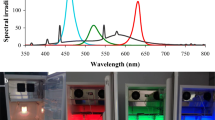Abstract
Among the three different light sources viz. incandescent electric light, infra-red light and sunlight, only sunlight was effective in inducing sporulation in petri dish cultures ofA. solani. The intensity of sporulation depended upon the age and growth stage of the cultures, duration and number of exposures to light and the presence or absence of a sporulating zone in the culture. Maximum sporulation was obtained in the case of 6 days old partially grown cultures by inducing the formation of sporulating zone which appeared in 24 hours after every exposure of 60 minutes to sunlight.
Similar content being viewed by others
References
Bisby, G. R. (1925) Zonation in cultures of Fusarium discolor sulphureum. Mycologia 17: 89–97.
Brown, W. (1925) Studies in the genus Fusarium. II. An analysis of factors which determine the growth forms of certain strains. Ann. Botany 39: 373–408.
Beecher, F. S. (1945) Light and composition of media as factors inducing sporulation in strains of Alternaria solani. Phytopath. 35: 483.
Barksdale, T. H. (1968) A method of screening for resistance to early blight on tomato seedlings. Phytopathology 58: 883 (Abstr.).
Charlton, K. M. (1953) The sporulation of Alternaria solani in culture. Trans. Brit. Mycol. Soc. 36: 349–355.
Dillon Weston, W. A. R. (1936) The sporulation of Helminthosporium avenae and Alternaria solani in artificial culture. Trans. Brit. Mycol. Soc. 20: 112–115.
Ellis, M. (1931) Some experimental studies on Pleospora herbarum (Pers.) Rabenh. Trans. Brit. Mycol. Soc. 16: 102–114.
Gupta, S. K. & Pushkarnath (1962) Inducing sporulation in artificial culture of Alternatia solani (E. & M.) J. & G. Mycopath. Mycol. Appl. 17: 82–88.
Hafiz, A. (1951) Cultural studies on Ascochyta rabiei with special reference to zonation. Trans. Brit. Mycol. Soc. 34: 259–269.
Lukens, R. J. (1960) Conidial production from filter paper cultures of Helminthosporium vagans and Alternaria solani. Phytopath. 50: 867–868.
McCallan, S. E. A. & S. Y. Chan (1944) Inducing sporulation of Alternaria solani in culture. Contrib. Boyce. Thmpson Inst. 13: 323–335.
Rands, R. D. (1917) The production of spores of Alternaria solani in pure culture. Phytopathology 7: 316–317.
Snyder, W. C. & H. N. Hansen (1941) The effect of light on taxonomic characters in Fusarium. Mycologia 33: 580–591.
Singh, B. M. (1967) Inducing sporulation in different strains of A. solani. I. Effect of visible light. Mycopath. Mycol. Appl. 31: 144–150.
Singh, B. M. (1967a) Inducing sporulation in different strains of A. solani. II. Effect of ultraviolet light Mycopath. Mycol. Appl. 32: 163–171.
Author information
Authors and Affiliations
Rights and permissions
About this article
Cite this article
Prasad, B., Dutt, B.L. Inducing sporulation in Alternaria solani II. Effect of light. Mycopathologia et Mycologia Applicata 54, 47–54 (1974). https://doi.org/10.1007/BF02055972
Issue Date:
DOI: https://doi.org/10.1007/BF02055972




